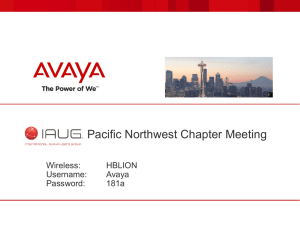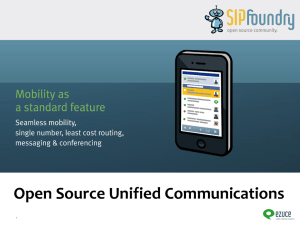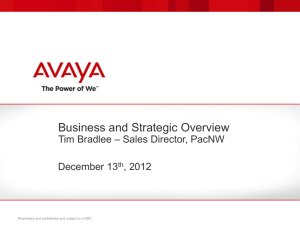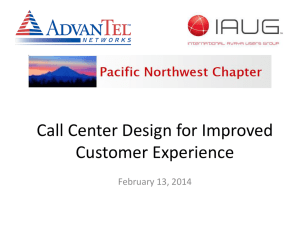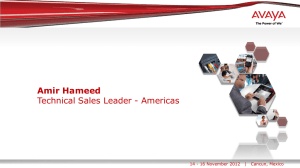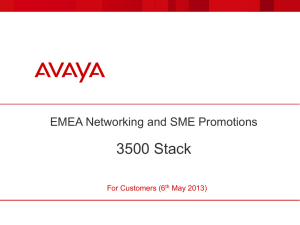Singh-Cloud-Based-Services-Industry-Trends-and
advertisement
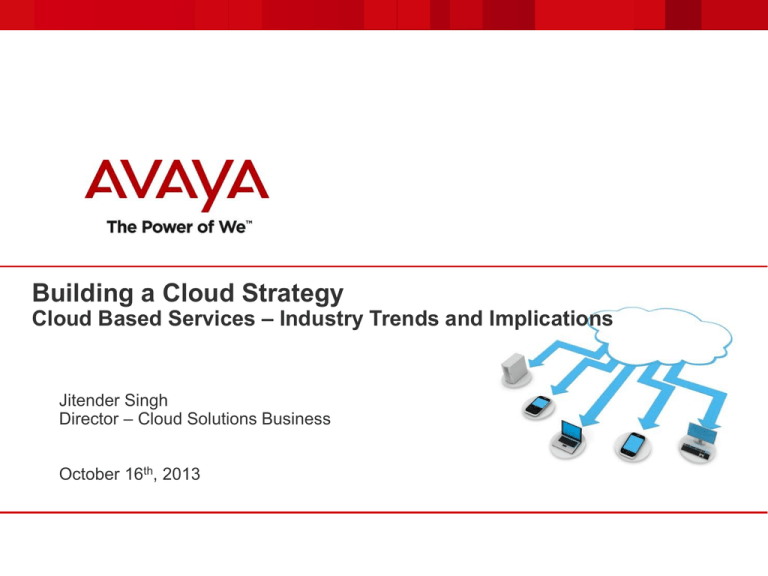
Building a Cloud Strategy Cloud Based Services – Industry Trends and Implications Jitender Singh Director – Cloud Solutions Business October 16th, 2013 PaaS IaaS SaaS CaaS Managed Cloud Private Cloud Public Cloud Avaya - Proprietary. Use pursuant to your signed agreement or Avaya policy. Hybrid Cloud Avaya Confidential – Shared under NDA 2 Customers are seeking Creative Business Models Customer Drivers for OPEX Models Cash Management: Consume all network, telephony and applications Flexible Delivery Options Up-scale, down-scale on demand Hosted, On Premise Managed, Hybrid Managing and Reducing IT Complexity Reluctance to hire staff to manage VoIP/UC Managed Services Outsourced (COS) Hosted Assets on premise Owned by Customer Assets on premise Assets hosted by 3rd Party Owned by 3rd Party Managed by 3rd Party Managed by 3rd Party 3rd Owned by Party Managed by 3rd Party technology complexity End-to-end SLA Total Cost of Ownership Potential for cost savings, including people, capital OPEX MODELS as a service Use capital in other areas of business & operating cost Virtualization and shared infrastructure lowers the cost to deliver services Managing Obsolescence Refresh as technology evolves Corporate-wide Standardization Customer facing differentiation Implication Dedicated (Private) Shared Multitenant (Public) Hybrid (Assets on Premise Apps from cloud) Cloud Services Large Enterprises are not quite sure as to what implications Cloud will have on their business, but are expecting a solution that offers cost savings, control, leverage and security first and scalability, flexibility, standardization and homogeneity in the long-run Avaya - Proprietary. Use pursuant to your signed agreement or Avaya policy. Avaya Confidential – Shared under NDA 3 Avaya - Proprietary. Use pursuant to your signed agreement or Avaya policy. Avaya Confidential – Shared under NDA 4 Market View Global Cloud Communications Market growing to $27B at 8% CAGR by 2017 Transition to Cloud • The various workplace technology markets will adopt cloud based strategies at different rates • Trend to cloud is being led by hosted apps - i.e. Email, IM, Avaya LiveEngage, Conferencing, CRM, ERP (like SFDC, SAP) and laying the groundwork for hosted voice • Hosted and Managed services - help customers make the transition to an all IP converged collaboration. • Hybrid Solution – Interim step as Enterprises consider migration to Hosted / cloud Note: UCaaS, CCaaS, VaaS forecast includes Professional Services, Maintenance and Solution revenue for Private +Public offered through Managed, Hosted and SaaS Source: 2013 June Avaya Demand Forecast, Avaya Market Assessment $1.4M Avg $3.5M Avg Avaya - Proprietary. Use pursuant to your signed agreement or Avaya policy. Avaya Confidential – Shared under NDA 5 Avaya - Proprietary. Use pursuant to your signed agreement or Avaya policy. Avaya Confidential – Shared under NDA 6 Top Business Drivers for Cloud – Large Enterprise There are a group of business drivers that combine to make hosted the preferred model and are difficult to sell against without a hosted solution. Avaya – Confidential & Proprietary 7 Market Segmentation Customer Needs and Opportunity Small Businesses • Needs Simplicity and Pricing - Fixed cost, No worry Help me focus on my business Make me look bigger and more professional Never miss a call; (missed call = missed revenue) Front office capability Simple productivity apps (e.g. voicemail to email) Midmarket • Access Price Agility Needs Bundles and Solutions - High functionality and productivity, but make it easy Multisite, flexible growth (e.g. add new office, grow/shrink usage) Ideal segment for managed / hosted Large Enterprises • Elasticity Security Customization SLA Needs Integration • • • Sites, disparate CPE, IT apps, Security, SLA’s GLOCAL support from ‘trusted’ partner Avaya - Proprietary. Use pursuant to your signed agreement or Avaya policy. Control 8 Deployment Options for Large Enterprise TCO of Hosted model is 13% lower in 3 year timeframe 3 Year Dollars TCO per foruser Large Enterprise (Dollars per User) 40000 seats Spend category Hardware Software Ongoing operational support Implement and Deploy On-premise UC 204 Managed UC 210 561 Data Center Ops/IT Resources Bandwidth Key Drivers 216 vs. OnHosted premise UC 3% 199 389 -3% 227 216 53 26 Training 25 14 12 NWDC facilities 10 10 0 SW License Fees/Subscriptions 138 138 -24% 38 Handsets 203 PBXs/Servers 10 Maintenance 15 -35% • On-premise - Maintenance of network, servers, handsets requires 77 FTEs • Managed - Maintenance of servers, handsets offset by increased maintenance cost • Hosted - Maintenance of handsets offset by increased subscription cost 228% • On-premise - Cost of initial licenses, support and update • Managed - Cost of initial licenses, and S/W update • Hosted - Cost of subscription & handsets -99% • On-premise - Cost of initial servers, handsets and server maintenance • Managed - Cost of initial servers, handsets and total maintenance • Hosted - Cost of initial gateways 643 -20% 58 19 0 203 0 71% 10 • Managed - Initial installation costs of handsets & management • Hosted - Initial installation costs of handsets & hosting 285 Moves/changes Software Support/Update vs. On• On-premise - Initial installation costs of premise UC servers/handsets 177 2 0 Total Cost of Ownership 1,492 1,412 -5% 1,406 -6% Total NPV of Ownership 947 902 -5% 820 -13% Avaya – Confidential & Proprietary 9 TCO Savings Sensitivity – over 3 years 100 Seats SME Vs. 1000 Seats Medium Enterprise 3 year TCO savings for a 100 seat deployment ($ / user) 3 year TCO savings for a 1000 seat deployment ($ / user) Illustrative Only – not per scale % TCO Savings 25% # Seats 100 1,000 40,000 22% TCO Savings 22% 25% 13% 13% A sweet spot for TCO savings exists potentially between 1,000 and (10,000?) seats 100 1,000 40,000 # Enterprise Seats Avaya – Confidential & Proprietary 10 Deployment Options for Large Enterprise TCO of Hosted model is similar to On-premise in 5 year timeframe 5 YearDollars TCO per foruser Large Enterprise (Dollars per User) 40000 seats Spend category Hardware Software Ongoing operational support Implement and Deploy On-premise UC 204 Managed UC 210 935 Data Center Ops/IT Resources Bandwidth Key Drivers 360 vs. OnHosted premise UC 3% 199 648 -3% 378 360 88 44 Training 25 14 12 NWDC facilities 17 17 0 SW License Fees/Subscriptions 138 138 -24% 63 -35% 1,072 -28% 97 Handsets 203 PBXs/Servers 10 Maintenance 26 32 203 • On-premise - Cost of initial licenses, support and update • Managed - Cost of initial licenses, and S/W update • Hosted - Cost of subscription & handsets -99% • On-premise - Cost of initial servers, handsets and server maintenance • Managed - Cost of initial servers, handsets and total maintenance • Hosted - Cost of initial gateways 0 113% 294 2 • On-premise - Maintenance of network, servers, handsets requires 77 FTEs • Managed - Maintenance of servers, handsets offset by increased maintenance cost • Hosted - Maintenance of handsets offset by increased subscription cost 356% 0 10 • On-premise - Initial installation costs of servers/handsets • Managed - Initial installation costs of handsets & management • Hosted - Initial installation costs of handsets & hosting 476 Moves/changes Software Support/Update vs. Onpremise UC 0 Total Cost of Ownership 2,101 1,970 -6% 2,201 5% Total NPV of Ownership 1,147 1,082 -6% 1,130 -1% Avaya – Confidential & Proprietary 11 Example Validates our TCO hypothesis and model Customer Scope EMEA – 125,000 users (50,000 users would move to hosted) NAR – 500,000 users (100,000 – 200,000 users would move to hosted) 8,451 sites in NAR and approx 1,000 sites in EMEA (5% large sites with 1000 users and up) Top Business Drivers Flexibility to scale up and down based on usage Shifting risk to service provider / Managing Technology obsolescence Moving from Capex to Opex Standardization TCO savings (perceived – but not always realized) Current network topology is 1 data center supporting all sites. TCO Profile Evaluated On-premise, hosted and managed options over 3, 5 and 7 year horizon Savings from hosted not as large as expected – Hit or miss depending upon the site – Savings from staffing, datacenter operations considered as soft costs – Enterprise has a very lean, highly skilled staff at good rates – potential for retrain and redeploy Bandwidth costs for hosted not considered significant – Bandwidth costs are a significant cost driver within the enterprise network (e.g. when adding a new site) – Incremental bandwidth costs between private network and CSP do not impact TCO significantly Savings realized from SIP trunking – Though WAN upgrades at sites offset savings achieved by negating local GW requirements Avaya – Confidential & Proprietary 12 Avaya - Proprietary. Use pursuant to your signed agreement or Avaya policy. Avaya Confidential – Shared under NDA 13
